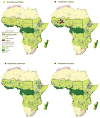Chromosome inversions and ecological plasticity in the main African malaria mosquitoes
- PMID: 28071788
- PMCID: PMC5340588
- DOI: 10.1111/evo.13176
Chromosome inversions and ecological plasticity in the main African malaria mosquitoes
Abstract
Chromosome inversions have fascinated the scientific community, mainly because of their role in the rapid adaption of different taxa to changing environments. However, the ecological traits linked to chromosome inversions have been poorly studied. Here, we investigated the roles played by 23 chromosome inversions in the adaptation of the four major African malaria mosquitoes to local environments in Africa. We studied their distribution patterns by using spatially explicit modeling and characterized the ecogeographical determinants of each inversion range. We then performed hierarchical clustering and constrained ordination analyses to assess the spatial and ecological similarities among inversions. Our results show that most inversions are environmentally structured, suggesting that they are actively involved in processes of local adaptation. Some inversions exhibited similar geographical patterns and ecological requirements among the four mosquito species, providing evidence for parallel evolution. Conversely, common inversion polymorphisms between sibling species displayed divergent ecological patterns, suggesting that they might have a different adaptive role in each species. These results are in agreement with the finding that chromosomal inversions play a role in Anopheles ecotypic adaptation. This study establishes a strong ecological basis for future genome-based analyses to elucidate the genetic mechanisms of local adaptation in these four mosquitoes.
Keywords: Anopheles; chromosome inversions; ecological divergence; local adaptation; parallel evolution.
© 2017 The Author(s). Evolution © 2017 The Society for the Study of Evolution.
Figures




References
-
- Akaike H. New look at statistical-model identification. Ieee Transactions on Automatic Control. 1974;AC19:716–723.
-
- Annan Z, Durand P, Ayala FJ, Arnathau C, Awono-Ambene P, Simard F, Razakandrainibe FG, Koella JC, Fontenille D, Renaud F. Population genetic structure of Plasmodium falciparum in the two main African vectors, Anopheles gambiae and Anopheles funestus. Proc Natl Acad Sci U S A. 2007;104:7987–7992. - PMC - PubMed
Publication types
MeSH terms
Associated data
Grants and funding
LinkOut - more resources
Full Text Sources
Other Literature Sources
Molecular Biology Databases
